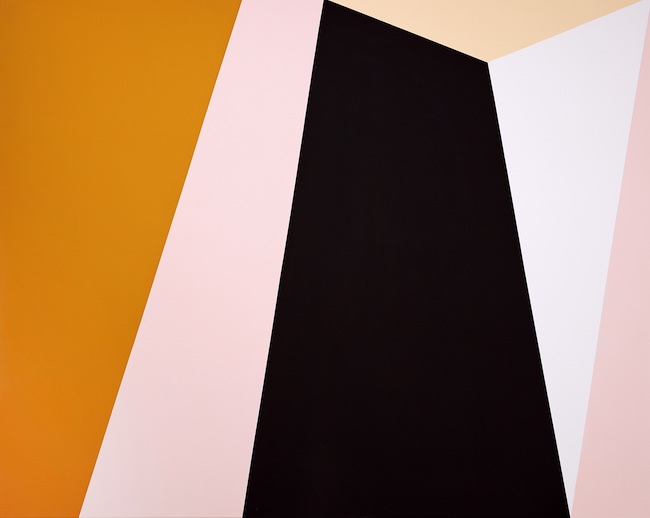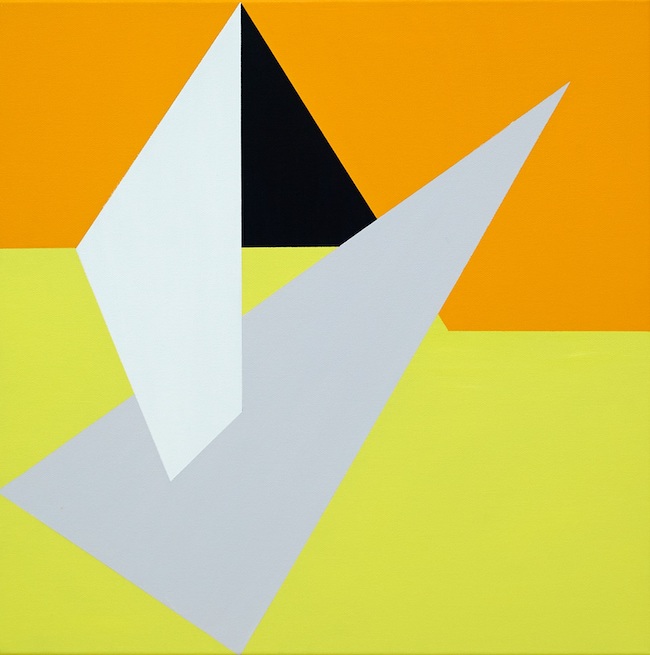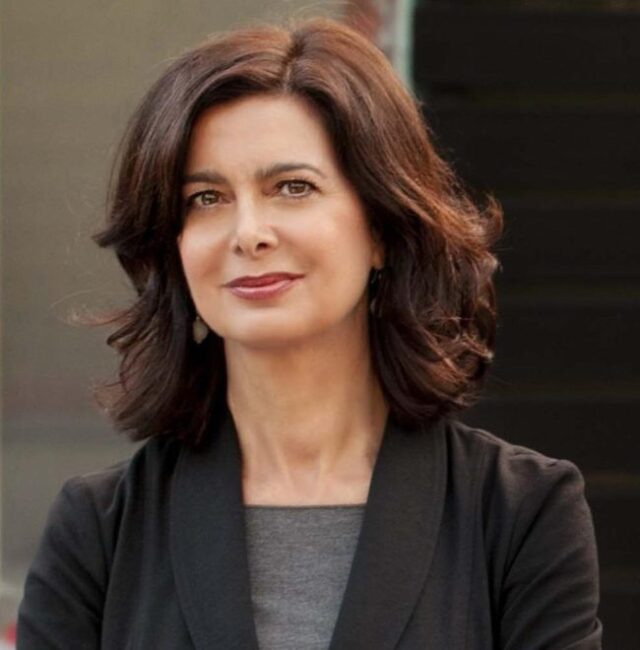La forma definita e lineare è sempre stata un mezzo per gli artisti per andare a studiare la plasticità, l’atto creativo fine a se stesso, come manifestazione d’arte sublime e superiore, depurata da ogni sensazione soggettiva che ne inficerebbe il risultato di ricerca e di studio della bidimensionalità, e di quanto il completo distacco dalla realtà osservata costituisca in ogni caso una modalità espressiva in grado di coinvolgere esattamente in virtù di quella rigidità figurativa. La protagonista di oggi, in maniera inconsapevole, riesce a infondere nelle sue opere un senso di tensione verso l’indefinitezza, quell’andare oltre i limiti della tela che trapela e si trasmette all’osservatore.
Quando nel primo ventennio del Novecento si delineò il movimento pittorico dell’Astrattismo una parte degli artisti aderenti a quella nuova modalità creativa entrò in antitesi con i concetti dei suoi fondatori, tra cui Vassilij Kandinskij, che legavano la dissonanza dalla forma osservata al senso di spiritualità che in ogni caso doveva permeare l’opera e dei colori sapientemente utilizzati per suscitare le emozioni volute nel fruitore della tela. Per coloro che decisero di allontanarsi da questo concetto invece il gesto plastico di generazione di un’opera doveva essere totalmente privo di ogni soggettività dell’artista, di ogni sentimento o emozione che potessero distogliere l’attenzione dalla purezza dell’atto creativo; per raggiungere questo risultato gli esponenti del De Stijl, o Neoplasticismo, delinearono alcune linee guida essenziali a cui gli aderenti al movimento dovevano attenersi. L’annullamento della terza dimensione, la scelta di limitarsi ai colori primari come il giallo, il rosso, il blu, il bianco e il nero, e l’utilizzo di linee e della figura geometrica del rettangolo furono gli elementi imprescindibili delle opere di Pete Mondrian e di Theo Van Doesburg che raccolsero le basi teorizzate da Kasimir Malevic ampliandole e rendendole più rigorose. Il movimento aveva però dei limiti da cui i suoi stessi fondatori restarono intrappolati, come il rifiuto delle linee oblique, della forma curva e tondeggiante e l’opposizione ad assumere una gamma cromatica più ampia; questo provocò l’estinzione del movimento del De Stijl che però aveva incontrato il favore di molti artisti europei che lo trasformarono dando vita all’Astrattismo Geometrico di cui Manlio Rho e Mario Radice, della Scuola di Como, furono massimi esponenti, così come la scuola sorta presso la galleria Il Milione di Milano ebbe come grandi rappresentanti Mauro Reggiani e Luigi Veronesi. L’Astrattismo Geometrico lasciò gli artisti molto più liberi di assecondare la propria indole espressiva sia nella scelta dei colori, sia anche per l’apertura a forme differenti rispetto a quelle limitate del Neoplasticismo, come i quadrati, i triangoli, le linee curve, i pentagoni e le diagonali, che di fatto diedero l’opportunità al pubblico che spesso tendeva a restare un po’ distaccato dalle opere a causa di una mancanza di formazione intellettuale, di avvicinarsi invece in virtù di tonalità più chiare e luminose, di uno stimolo all’interpretazione di quelle forme che in fondo, malgrado la non intenzione dell’autore, possono comunque svelare un approccio, un pensiero filosofico che trapela. L’artista danese Ulla Viebeke Ferdiandsen arriva all’Astrattismo Geometrico dopo un percorso meno rigoroso, meno scientifico, come se la destinazione finale fosse una sua necessità di studiare il gesto plastico da un punto di vista differente, meno coinvolto con il lato emozionale e decisamente più orientato all’analisi dell’accostamento tra colori e forme.
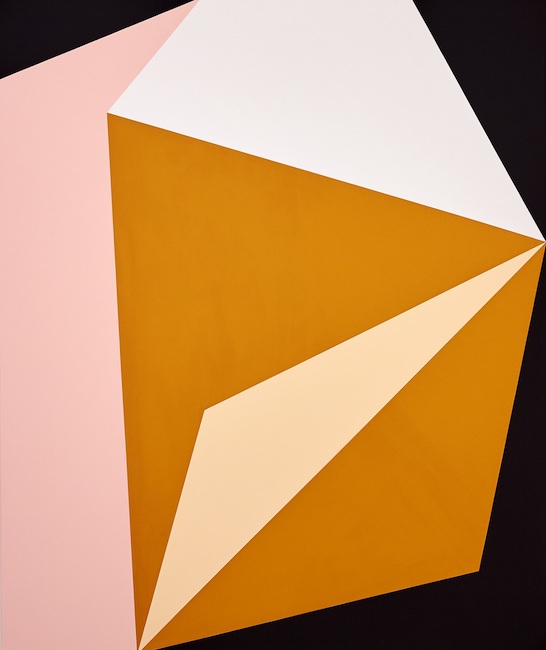
Ciò che colpisce della sua analisi sulle forme è la scelta della gamma cromatica, sempre solare, positiva, aperta all’interazione della contiguità, di toni in gradazione armonica, mentre i colori primari sottolineano semplicemente l’esistenza di un elemento che rompe lo schema dell’ordine, oppure lo sottolinea, in ogni caso il suo apparire è determinante per la costruzione dell’intera composizione.
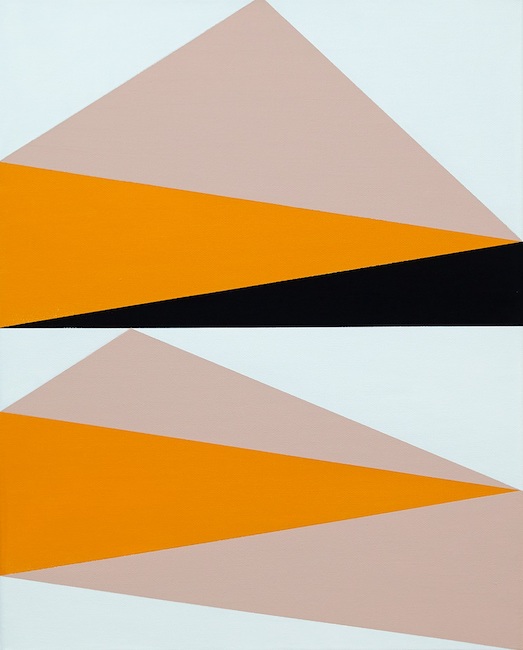
Nell’universo creativo, tanto quanto in quello esistenziale, tutto ciò che accade, che appare e che sembra essere perfettamente pianificato può entrare in crisi nel momento in cui sopraggiunge un imprevisto, costituito dalla disarmonia come nelle opere Untitled I (Senza titolo I) e Untitled II (Senza titolo II) in cui il nero sembra destabilizzare, sbrecciare il predeterminato per poi uniformarsi, o meglio inglobarsi in esso per dare vita a un nuovo ordine differente. Sembra una metafora sul senso dell’esistenza quella a cui inconsapevolmente fa riferimento Ulla Vibeke Ferdinandsen, la costante altalena tra salite e discese, tra i momenti di tranquillità e di stabilità e quelli di incertezza o di dissoluzione del conosciuto per entrare in un campo sconosciuto che poi lentamente diviene non solo più familiare bensì anche quello a cui ci si riesce ad adeguare; in fondo l’evoluzione dell’individuo richiede costanti sforzi di adattamento alle situazioni che sopraggiungono, alle circostanze che si susseguono e agli eventi che si verificano. Dunque le ombre del nero in qualche modo, malgrado l’apparenza inizialmente cupa, riescono invece a esaltare al meglio i colori che lo accolgono.

Anche in Untitled (Senza titolo) la lama scura sembra voler rompere quel moderato bilanciamento cromatico fatto di gradazioni tenui e delicate, come se in qualche modo il suo arrivo costituisse un semplice passaggio, un percorso obbligato verso la successiva evoluzione; già in questa tela si manifesta in modo evidente il tendere della Ferdiandsen verso l’infinito, un costante progredire che non le consente di dare un inizio e una fine alla tela, o per meglio dire, le opere sembrano continuare anche oltre il limite del dipinto stesso. La geometria dunque esplora, studia la forma e la sua presenza nello spazio, la continuità o la discordanza dei colori rappresentano un’analisi sul risultato finale che raggiunge l’osservatore, così come l’accostamento tra forme diverse genera un effetto ottico che le rende tutte parimenti protagoniste della tela.

Il desiderio di dare un ordine alle cose porta l’artista a cercare un senso mentale e razionale verso la plasticità dell’opera in sé, tuttavia dai suoi dipinti non può fare a meno di fuoriuscire anche la sua filosofia di vita, quell’apertura all’esistenza con tutte le sue sfaccettature, quel saper accogliere ciò che accade e trasformarlo, senza alcuna resistenza o atteggiamento negativo, in una nuova realtà da vivere in pieno cambiando se stessa sulla base degli eventi, delle circostanze che, inevitabilmente, si susseguono nella vita di ciascuno.
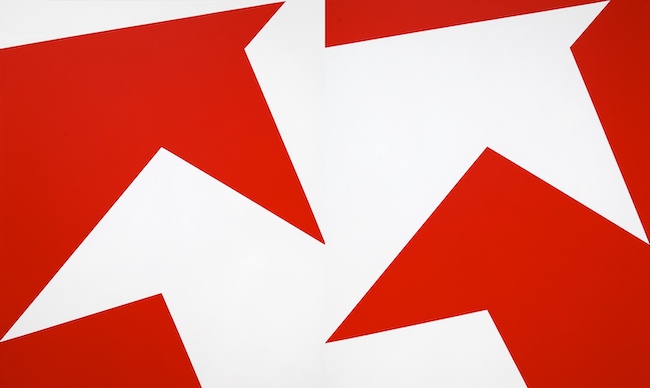
Positiv Negativ (Positivo Negativo) è l’opera più legata a questo concetto, a questo approccio all’esistenza della Ferdiandsen in cui appare evidente quanto l’immagine stessa sia un frammento di un percorso di interazione, qualcosa che non ha un inizio né una fine poiché ogni cosa può essere la conseguenza o il risultato di un recente passato e possa condurre verso un ignoto futuro, una non conosciuta progressione.
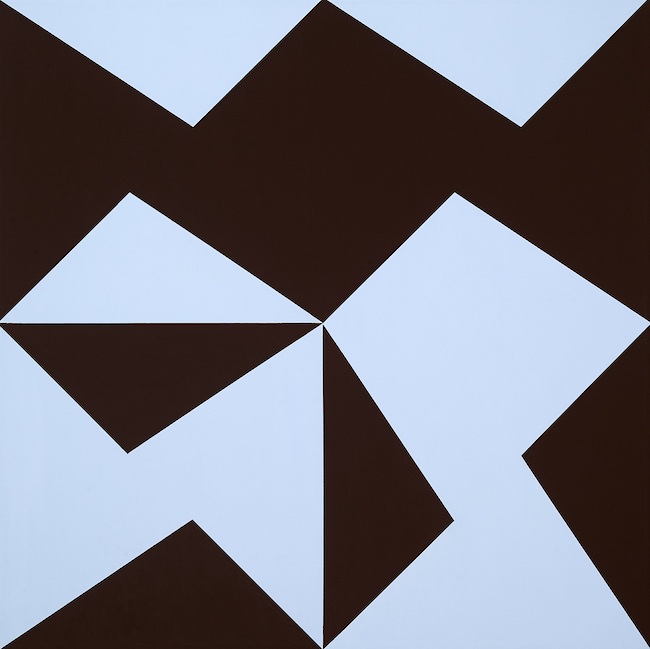
Non esistono margini nella composizione geometrica, la fine della tela non ferma l’evoluzione dell’essenza del cammino, sembra suggerire l’artista che sceglie non più il nero per rappresentare il negativo, bensì il rosso, come se volesse evidenziare che in fondo anche l’esperienza più triste o brutta possa essere volta al meglio se si ha la capacità di trarne l’insegnamento migliore e attingere a essa per andare avanti verso un nuovo domani. Ulla Vibeke Ferdiandsen, formatasi da autodidatta, dipinge dal 1991 e nel corso di questa lunga carriera ha partecipato a moltissime mostre collettive e personali negli Stati Uniti, in Danimarca, in Francia, in Germania e in Svezia, è presente in molti cataloghi d’arte e ha vinto diversi premi per il suo valore artistico.
ULLA VIBEKE FERDINANDSEN-CONTATTI
Email: ulla.ferdinandsen@gmail.com
Sito web: www.ullaferdinandsen.dk
Facebook: https://www.facebook.com/ulla.ferdinandsen
Instagram: https://www.instagram.com/ulla.ferdinandsen/
Geometric rigour tending towards the infinite in the artworks of Ulla Vibeke Ferdinandsen
Defined and linear form has always been a means for artists to study plasticity, the creative act as an end in itself, as a sublime and superior manifestation of art, purified of any subjective sensation that would invalidate the result of research and study of two-dimensionality, and of how complete detachment from observed reality constitutes in any case a mode of expression capable of involving precisely by virtue of that figurative rigidity. Today’s protagonist, in an unconscious manner, manages to infuse her artworks with a sense of tension towards indefiniteness, that goes beyond the limits of the canvas that leaks out and is transmitted to the observer.
When the Abstractionism movement emerged in the first twenty years of the 20th century, some of the artists who adhered to this new creative mode were in conflict with the concepts of its founders, including Vassily Kandinsky, who linked the dissonance of the observed form to the sense of spirituality that should in any case permeate the artwork and the colours skilfully used to arouse the desired emotions in the viewer of the canvas. For those who decided to move away from this concept, on the other hand, the plastic gesture of creating a work had to be totally devoid of any subjectivity on the part of the artist, of any feeling or emotion that might distract attention from the purity of the creative act; to achieve this result, the exponents of De Stijl, or Neoplasticism, outlined certain essential guidelines that the adherents of the movement had to follow. The elimination of the third dimension, the choice of limiting oneself to primary colours such as yellow, red, blue, white and black, and the use of lines and the geometric figure of the rectangle were the essential elements of the paintings of Pete Mondrian and Theo Van Doesburg, who took up the bases theorised by Kasimir Malevic, expanding them and making them more rigorous.
However, the movement had limitations that its founders were trapped by, such as the rejection of oblique lines, curved and rounded forms and the opposition to take on a wider colour range; this caused the extinction of the De Stijl movement, which had, however, met the approval of many European artists who transformed it, giving rise to Geometric Abstractionism, of which Manlio Rho and Mario Radice, from the School of Como, were the greatest exponents, just as the school that sprang up at the Il Milione gallery in Milan had Mauro Reggiani and Luigi Veronesi as its great representatives. Geometric Abstractionism left artists much freer to indulge their expressive nature both in their choice of colours and in their openness to different forms than the limited ones of Neoplasticism, such as squares, triangles, curved lines, pentagons and diagonals, which in fact gave the public, who often tended to remain somewhat detached from the artworks due to a lack of intellectual training, the opportunity to approach them by virtue of brighter and more luminous tones, of a stimulus to interpret those forms which in the end, despite the author’s lack of intention, can still reveal an approach, a philosophical thought that leaks through. The Danish artist Ulla Vibeke Ferdinandsen arrives at Geometric Abstractionism after a less rigorous, less scientific path, as if the final destination her need was to study the plastic gesture from a different point of view, less involved with the emotional side and decidedly more oriented towards the analysis of the combination of colours and forms. What is striking about her analysis of forms is the choice of the chromatic range, always sunny, positive, open to the interaction of contiguity, of tones in harmonic gradation, while the primary colours simply underline the existence of an element that breaks the pattern of order, or emphasises it, in any case its appearance is decisive for the construction of the entire composition.
In the creative universe, as well as in the existential one, everything that happens, that appears and seems to be perfectly planned can go into crisis at the moment in which occurs an unexpected event, constituted by disharmony, as in the paintings Untitled I and Untitled II in which black seems to destabilise, to break up the predetermined and then conform, or rather to incorporate itself into it to give life to a new, different order. It seems to be a metaphor on the meaning of existence that Ulla Vibeke Ferdinandsen unconsciously refers to, the constant seesaw between ups and downs, between moments of tranquillity and stability and those of uncertainty or dissolution of the known to enter an unknown field which then slowly becomes not only more familiar but also the one to which one can adapt; after all, the evolution of the individual requires constant efforts to adapt to the situations that arise, to the circumstances that follow one another and to the events that occur. So the shadows of black somehow manage, despite its initially gloomy appearance, to bring out the best in the colours that surround it. In Untitled, too, the dark blade seems to want to break that moderate chromatic balance made up of soft and delicate gradations, as if in some way its arrival constituted a simple passage, an obligatory path towards the subsequent evolution; already in this canvas Ferdiandsen’s tendency towards infinity is clearly manifested, a constant progress that does not allow her to give a beginning and an end to the canvas, or rather, the artworks seem to continue beyond the limits of the painting itself.
Geometry therefore explores, studies form and its presence in space, the continuity or discordance of colours represents an analysis of the final result that reaches the observer, just as the juxtaposition of different forms generates an optical effect that makes them all equally protagonists of the canvas. The desire to give order to things leads the artist to seek a mental and rational sense towards the plasticity of the artwork itself, but her paintings cannot fail to reveal her philosophy of life, that openness to existence with all its facets, that ability to accept what happens and transform it, without any resistance or negative attitude, into a new reality to be lived to the full, changing herself on the basis of events and circumstances that inevitably follow one another in life. Positiv Negativ is the artwork most closely linked to this concept, to this approach to existence by Ferdiandsen, in which it is evident how much the image itself is a fragment of a path of interaction, something that has no beginning and no end, since everything can be the consequence or the result of a recent past and can lead towards an unknown future, an unknown progression.
There are no margins in the geometric composition, the end of the canvas does not stop the evolution of the essence of the path, seems to suggest the artist who no longer chooses black to represent the negative, but rather red, as if to highlight that in the end even the saddest or ugliest experience can be turned to the best if we have the ability to draw the best lessons from it and draw on it to move forward towards a new tomorrow. Ulla Vibeke Ferdinandsen, self-taught, has been painting since 1991. During her long career she has participated in many group and solo exhibitions in the United States, Denmark, France, Germany and Sweden, has been featured in many art catalogues and has won several awards for her artistic value.


